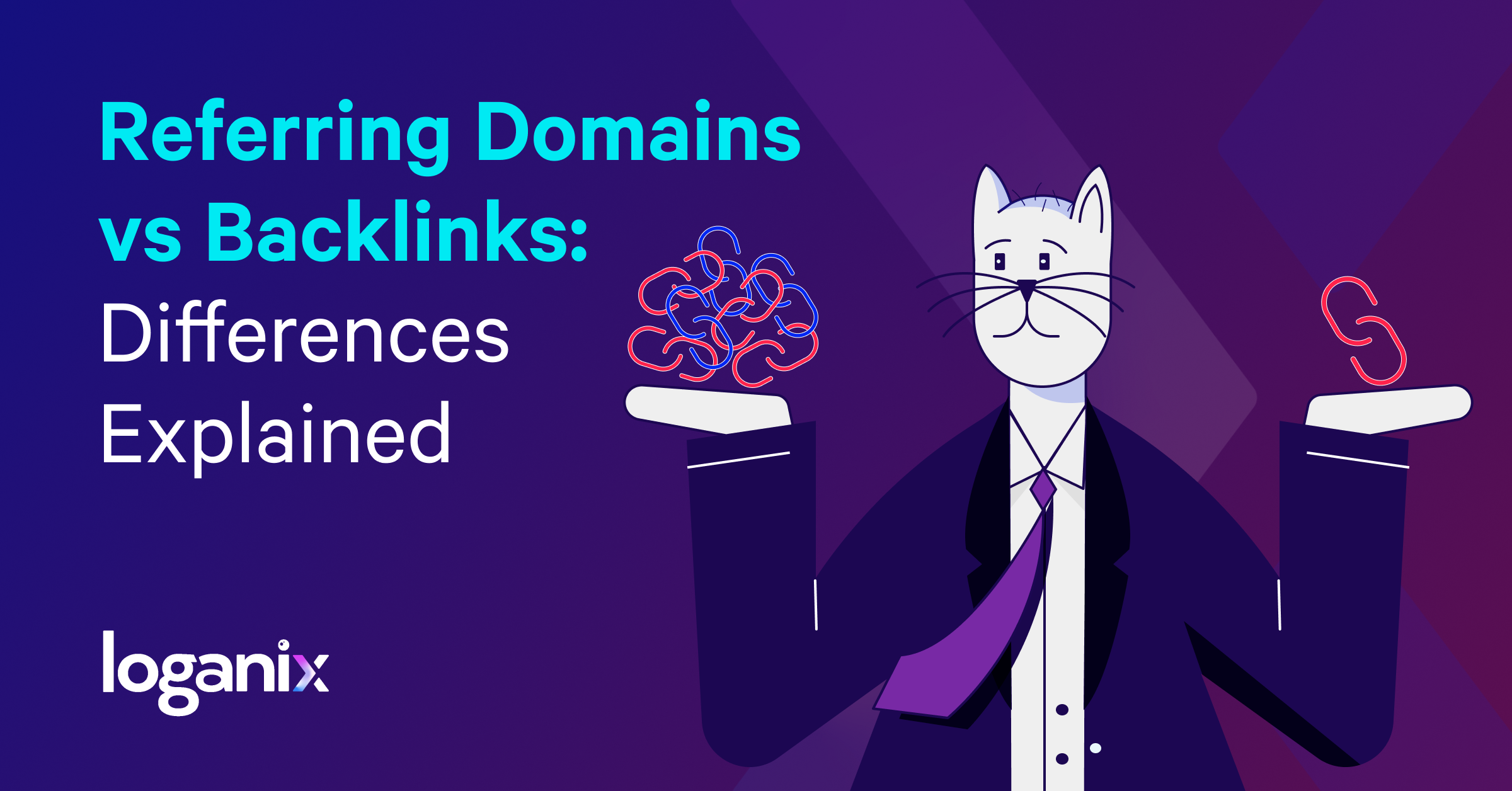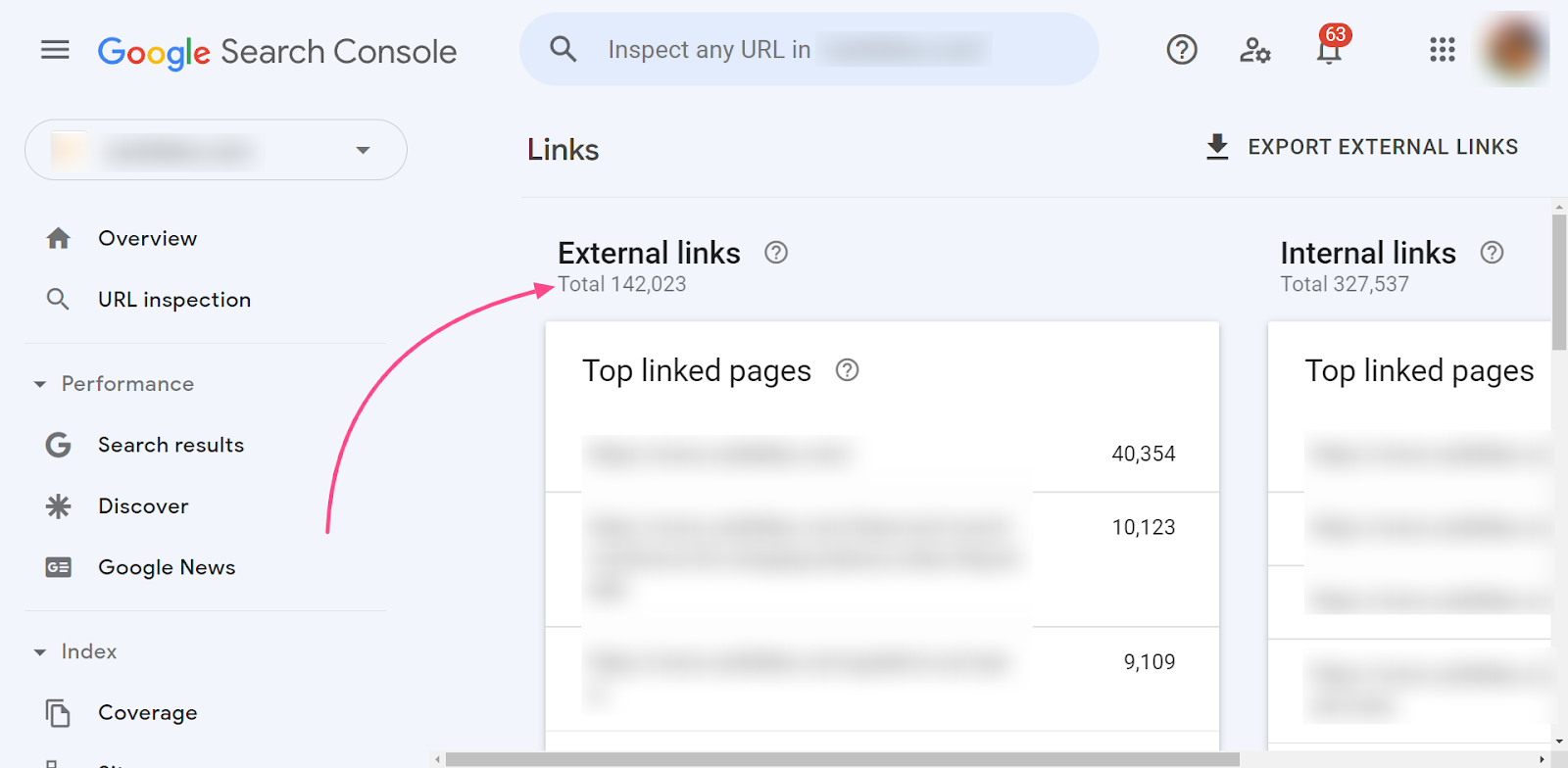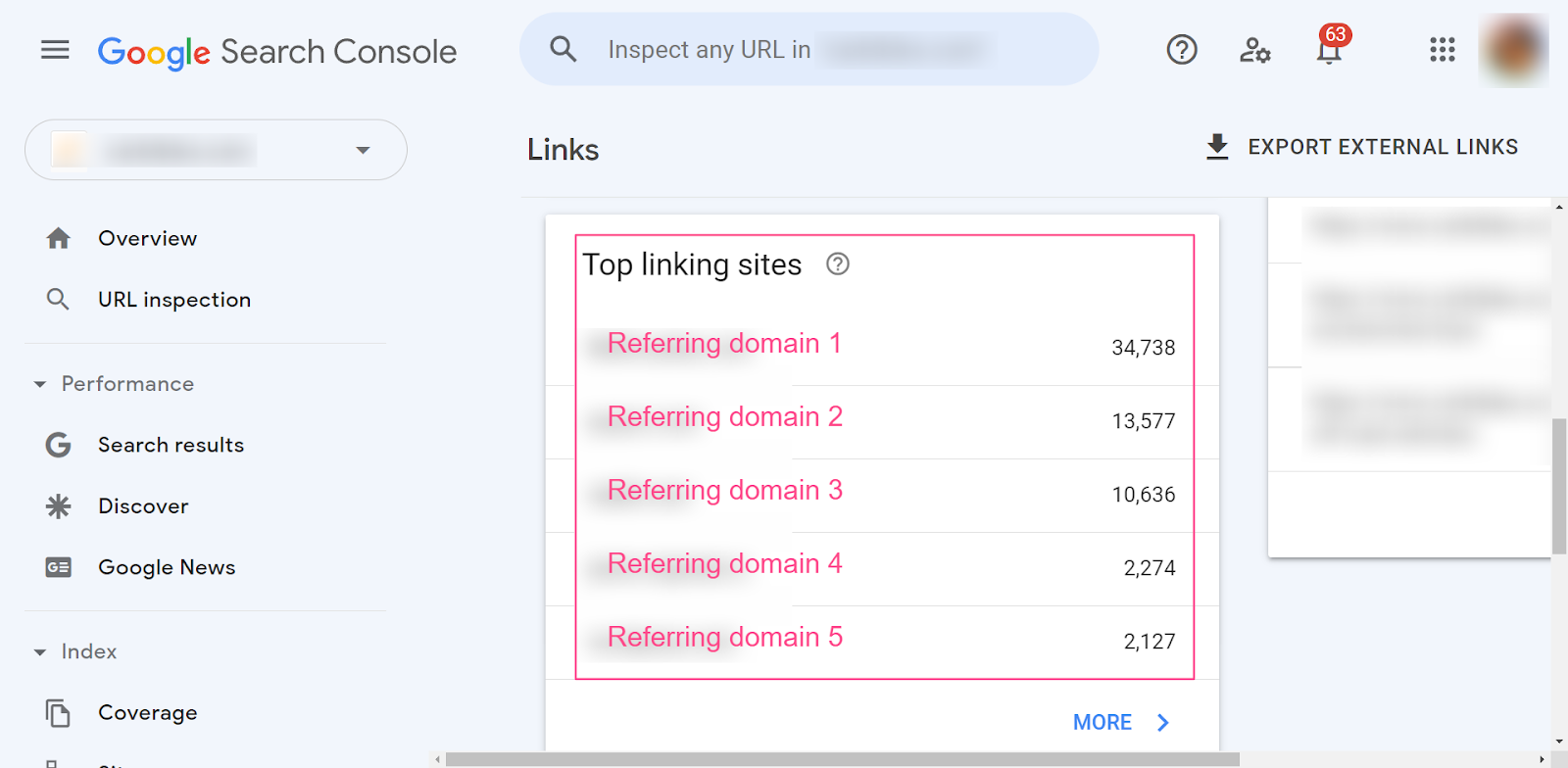Referring Domains vs Backlinks

Hand off the toughest tasks in SEO, PPC, and content without compromising quality
Explore ServicesBoth referring domains and backlinks are amongst some of the most important ranking factors for SEO – both metrics used by Google to determine how “rankable” your content is on the SERPs (search engine results pages).
To help you better understand these two search engine ranking factors, here we’ll:
- explain what backlinks and referring domains are,
- outline the similarities and differences between the two,
- and explain how they affect your website’s domain authority and its likelihood of ranking consistently on the SERPs.
Let’s jump into everything referring domains vs backlinks.
Referring Domains vs Backlinks
A backlink is a hyperlink that points from one website, the referring domain, to another website.
A website can receive multiple backlinks from one referring domain, the backlink being a product of the referring domain.
If a website receives a backlink from a third-party website, then it has one referring domain. If the same website receives two backlinks from the same referring domain, then it still has one referring domain but two backlinks.
Check out this example taken from the search engine optimization (SEO) tool, Ahrefs.

You can see that the example website has some 7,600 referring domains that have collectively linked out to the website around 74,400 times.
On average, each referring domain has linked out to the example website about 10 times each.
What are Referring Domains?
Referring domains, also known as linking domains, are websites that link out from one of their own web pages to another website’s web page.
Why are referring domains important for SEO?
Referring domains are a high-impact ranking factor (see our link building basics post for more info)
By receiving links from other sites, particularly dofollow links from high quality websites, it signals to Google (and other search engines) that your website is credible and valuable.
Take this example from the team over at Backlinko.

They conducted a study on no less than 11.8 million Google Search results.
The findings?
The top ranking pages on the SERPs had more referring domains than lower-ranking pages.
Therefore, it’s in your site’s best interest to obtain links from referring domains, as this will boost your domain authority and help your content rank.
Further reading: Link Building Benefits for SEO
What makes an authoritative referring domain?
In the context of SEO, it’s intuitive to think that the total number of referring domains that link out to a website is the most important ranking factor.
When in fact, it’s arguable that the quality or authoritativeness of a referring domain is the more important metric.
What makes a referring domain authoritative?
The authority of a referring domain is determined by:
- Trustworthiness – domains that are viewed by search engines as trustworthy, valuable, high-ranking, and credible.
- Relevance – websites linking out to your site from a related niche as your own.
- Strong backlink profile – the quality of a referring domain’s own backlink profile.
In theory, obtaining high-quality and authoritative links sounds easy enough. But it’s not always so straightforward, particularly when you’re starting a new website from the ground up.
If you are trying to put together a solid link building strategy and avoid common mistakes, there’s no doubt we can help you out with our link building services.
What are backlinks?
Backlinks, also referred to as inbound links or incoming links, are hyperlinks coming from a referring domain’s web page to another website’s web page.
There are many different types of backlinks, like:
- Editorial Backlinks
- Relationship-Based Backlinks
- Guest Blogging
- Directories
- Business Profile Backlinks
They don’t necessarily need to be hyperlinks added to text. Backlinks can also be added to images like infographics, tags from social media channels, or even as image captions.
Need more info or have some questions? Go here: 18 Link Building FAQs (Answered!)
Why are backlinks important for SEO?
There are a few worthwhile benefits of backlinks for SEO.
But one of the main reasons is to think of backlinks like a vote of confidence.
They attest to the credibility of a website and the content it contains – one site saying about another: “Hey Google, check it out! This site has some valuable information that we think is worth taking notice of.”
In other words, backlinks are a ranking signal that Google’s algorithm takes seriously.
How seriously?
Well, let’s look at the below bar graph from Ahrefs.

In this study, Ahrefs found that although web pages without backlinks will receive a small amount of monthly organic search traffic, the chances of a page that has zero backlinks receiving 1,000 monthly visits or more is very unlikely.
In fact, the 4 million pages represented by this graph only make up 5% of Ahrefs sample population.
The remaining 95% of the pages all had at least one backlink. In other words, only one in every 20 pages that didn’t have a single backlink received referral traffic.
1 in 20.
They’re probably not odds you’d want to bet on.
So if you want to increase your organic traffic and boost your content’s chances of ranking in the top positions, building a solid backlink profile is sure to help you achieve this.
What makes an authoritative backlink?
Just like referring domains, it’s not always the number of backlinks your website receives that is the most important ranking factor but, rather, the authoritativeness of a backlink.
Sure, a high number of backlinks will certainly help your site’s cause. But that’s not the only metric that is used to determine the overall quality of your website.
Rather,high-quality links are a greater determinant of a rankable website.
Authoritative or quality backlinks have a few things in common. These include:
- High domain authority – backlinks that point to your site from high domain authority websites are held in higher regard by Google than those from low authority sites. It’s important to note that backlinks from low authority sites aren’t always worthless. They just aren’t as valued by search engines as those sites referring domains that hold high authority.
- Relevance – search engines review the relevancy of a backlink to your site or the topic you’ve covered within the web page. For instance, a backlink from a web page that isn’t contextual or topically related isn’t as valuable as those backlinks that are on topic, are related to your industry niche, or that use an anchor text that’s relevant to the web page’s content.
- Anchor text – the keyword or phrase used to hyperlink to a web page matters. By using a related anchor text, the referring domain is giving contextual clues to search engines, allowing them to better understand what niche your site resides in.
- Unique referring domains – backlinks hold more weight if it’s difficult for your competitors to receive an inbound link from the same referring domain. In contrast, a web page that not only links out to you but also to several of your competitors won’t be as valuable.
Off topic backlinks are considered low-quality and may even hurt your site’s rankings rather than help.
On the other hand, niche-specific backlinks go a long way to creating high-quality content. If this sounds like something you’d like help with, check in on our authority link building services.
How to Check Backlinks + Referring Domains For Your Website (2 Methods)
You can check the authoritativeness of both backlinks and referring domains with the help of both a third-party or Google-developed SEO tool.
1. Ahrefs (Paid)
Ahrefs is a highly regarded SEO tool used by the best SEO experts and digital marketers in the industry. Here’s how to check in on your website’s backlinks and referring domains using this tool:
Step #1

Step #2
From the Ahrefs dashboard, click “Site Explorer” in the top left-hand corner.

Step #3
Enter your site’s domain extension into the Site Explorer search bar and hit the search button.

Step #4
Check it out! All your site’s metrics, including domain rating, backlinks, referring domains, and organic search traffic, all in one place.

Step #5
If you’d like to see an in-depth backlink report, simply click the “backlinks” portion of the panel.

Step #6
From here, you’ll be able to check out new backlinks you’ve recently received, how authoritative each referral domain is, and what anchor text they used to link out to your site.

2. Google Search Console (Free)
Similar to Google Analytics, Google Search Console (GSC) is a free tool that you can use to check on your backlinks and referring domains.
Here’s how:
Step #1
Head over to GSC and use your Google email address and password to log in.

Step #2
If you haven’t already, add your domain to GSC.

Step #3
From the toolbar, scroll down and click “Links”.

Step #4
Within the “External links” panel, you’ll notice your total backlinks.

Step #5
Finally, if you scroll down the page, within the “Top linking sites” panel, you’ll see the different domains that are linking out to your site as well as how many domain links you’ve received from each of these sites.

Backlinks vs Referring Domain FAQs
Are referring domains and backlinks the same?
No, they are not (have you read this article? 😏). Backlinks are the links on other websites that lead to your website. A website that links to your site is known as a referring domain. Despite the fact that one website can provide you with numerous backlinks, it only counts as one referring domain.
Are referring domains good?
Yes. Referring domains are ranking factors so can influence SEO rankings. These are actually regarded as high-impact ranking factors that affect your search engine optimization efforts. Each referring domain is viewed by Google as a recommendation from other websites.
What are the two types of backlinks?
When it comes down to it, backlinks come in two flavours: dofollow and nofollow. A web page reader won’t be able to tell the difference between a backlink that is dofollow and one that is nofollow. The source code is where the difference lies.
Are backlinks still relevant today?
Yes, in a nutshell, but they shouldn’t be your only tactic in your SEO strategy. Although not the main ranking element, backlinks are still highly significant. The primary distinction is in the best way to approach obtaining websites to link to your content.
What Are The Differences Between Referring Domains and Backlinks?
To recap:
- A backlink is an incoming link from an external website to your website.
- A referring domain is the website that adds an outbound link from their site to yours.
Whether you’re looking to develop a more comprehensive content marketing strategy or focusing on moving your site’s content up in the rankings, understanding the importance of referral domains and backlinks is a must.
With this knowledge, you can start building an SEO strategy that focuses on obtaining high-quality backlinks (white hat links) from credible referring domains (aka not black hat links).
That way, boosting your site’s organic traffic, pushing your content to the top of the SERPs, and out-competing your competitor will be easier than you ever thought possible.
Hand off the toughest tasks in SEO, PPC, and content without compromising quality
Explore ServicesWritten by Adam Steele on March 17, 2022
COO and Product Director at Loganix. Recovering SEO, now focused on the understanding how Loganix can make the work-lives of SEO and agency folks more enjoyable, and profitable. Writing from beautiful Vancouver, British Columbia.





